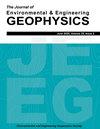A Case Study of Completely Buried Wind-Power Cable Detection Using 3D Acoustic Imaging
IF 0.7
4区 工程技术
Q4 ENGINEERING, GEOLOGICAL
引用次数: 0
Abstract
As offshore wind power is renewable energy produced through the installation and operation of large-scale offshore infrastructure, risk management is crucial in power platforms. Safety accidents caused by external factors during the operation of submarine power cables can lead to enormous costs, thus necessitating the monitoring of burial depth and route information of cables. In this study, we developed a 3D acoustic imaging method that obtains information on the route and depth of completely buried power cables. An acoustic source-based engineering ocean seismic 3D (EOS3D) system has been used to detect buried objects in the subsurface because conventional sonars, such as multi-beam echo sounder (MBES) and side-scan sonar (SSS), which are used to analyze seafloor characteristics, have limitations in detecting completely buried cables in the subsurface. Field data were obtained as 8-channel data using a chirp source (2–8 kHz) designed to obtain a 25 × 25 cm horizontal spatial resolution from real-time kinematic (RTK) positioning. The image stack method was proposed to effectively detect buried cables, with the vertical gradient analyzed using signals decomposed into representative bin sizes and low-mid-high-frequency components. The acoustic anomalies of buried objects, identified as export cables and protectors, were processed into images using the proposed image stack method and gradient analysis. This case study of buried wind power cables using 3D acoustic imaging could be utilized in burial assessment survey (BAS)-data acquisition, processing/analysis processes, and operation and management of buried cables.全埋式风电电缆三维声成像检测实例研究
由于海上风电是通过大型海上基础设施的安装和运营产生的可再生能源,因此风险管理对电力平台至关重要。海底电力电缆在运行过程中由于外部因素引起的安全事故会造成巨大的损失,因此需要对电缆的埋深和路由信息进行监测。在这项研究中,我们开发了一种三维声学成像方法,可以获得全埋电缆的路线和深度信息。基于声源的工程海洋地震3D (EOS3D)系统已被用于探测地下埋藏物体,因为传统的声纳,如多波束回声测深仪(MBES)和侧扫声纳(SSS),用于分析海底特征,在探测完全埋在地下的电缆方面存在局限性。现场数据为8通道数据,使用chirp源(2-8 kHz),通过实时运动学(RTK)定位获得25 × 25 cm的水平空间分辨率。提出了一种有效检测地埋电缆的图像叠加方法,并将信号分解为具有代表性的码仓大小和中低高频分量,对垂向梯度进行分析。利用所提出的图像叠加和梯度分析方法,将被识别为输出电缆和保护器的地埋物体的声异常处理成图像。本案例研究利用三维声成像技术对埋地风电电缆进行了研究,可用于埋地评估调查(BAS)的数据采集、处理/分析过程以及埋地电缆的运行和管理。
本文章由计算机程序翻译,如有差异,请以英文原文为准。
求助全文
约1分钟内获得全文
求助全文
来源期刊

Journal of Environmental and Engineering Geophysics
地学-地球化学与地球物理
CiteScore
2.70
自引率
0.00%
发文量
13
审稿时长
6 months
期刊介绍:
The JEEG (ISSN 1083-1363) is the peer-reviewed journal of the Environmental and Engineering Geophysical Society (EEGS). JEEG welcomes manuscripts on new developments in near-surface geophysics applied to environmental, engineering, and mining issues, as well as novel near-surface geophysics case histories and descriptions of new hardware aimed at the near-surface geophysics community.
 求助内容:
求助内容: 应助结果提醒方式:
应助结果提醒方式:


